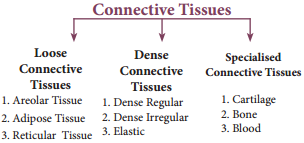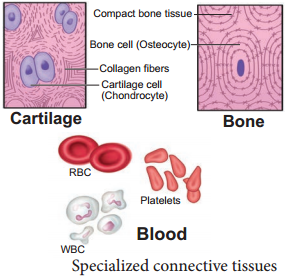Learninsta presents the core concepts of Biology with high-quality research papers and topical review articles.
An Overview Of Connective Tissue
Connective tissue develops from the mesoderm and is widely distributed in the body. There are three main classes namely Loose connective tissue, Dense connective tissue and Specialized connective tissue. Major functions of connective tissues are binding, support, protection, insulation and transportation.

Components of Connective Tissue
All connective tissues consist of three main components namely fires, ground substance and cells. The ‘Fibres’ of connective tissue provide support. Three types of fires are found in the connective tissue matrix. They are collagen, elastic and reticular fires.
Connective tissues are of three types namely, Loose connective tissues (Areolar, Adipose and Reticular) and Dense connective tissues (dense regular, dense irregular and elastic) and Specialized connective tissues (cartilage, bone and blood).
Loose Connective Tissues
In this tissue the cells and fires are loosely arranged in a semi fluid ground substances. For example the Areolar connective tissue beneath the skin acts as a support framework for epithelium and acts as a reservoir of water and salts for the surrounding body tissues, hence apply called tissue fluid. It contains firoblasts, macrophages, and mast cells (Figure 3.5).

Adipose tissue is similar to areolar tissue in structure and function and located beneath the skin. Adipocytes commonly called adipose or fat cells predominate and account for 90% of this tissue mass. The cells of this tissue store fats and the excess nutrients which are not utilised immediately are converted to fats and are stored in tissues. Adipose tissue is richly vascularised indicating its high metabolic activity. While fasting, these cells maintain life by producing and supplying energy as fuel.
Adipose tissues are also found in subcutaneous tissue, surrounding the kidneys, eyeball, heart, etc. Adipose tissue is called ‘white fat’ or white adipose tissue. The adipose tissue which contains abundant mitochondria is called ‘Brown fat’ or Brown adipose tissue. White fat stores nutrients whereas brown fat is used to heat the blood stream to warm the body. Brown fat produces heat by nonshivering thermogenesis in neonates.
Reticular connective tissue resembles areolar connective tissue, but, the matrix is filled with firoblasts called reticular cells. It forms an internal framework (stroma) that supports the blood cells (largely lymphocytes) in the lymph nodes, spleen and bone marrow. Dense connective tissues (connective tissue proper) Fibres and firoblasts are compactly packed in the dense connective tissues. Orientation of fires show a regular or irregular pattern and is called dense regular and dense irregular tissues.
Dense regular connective tissues primarily contain collagen fires in rows between many parallel bundles of tissues and a few elastic fires. The major cell type is firoblast. It attaches muscles and bones and withstands great tensile stress when pulling force is applied in one direction. This connective tissue is present in tendons, that attach skeletal muscles to bones and ligaments attach one bone to another. Dense irregular connective tissues have bundles of thick collagen fires and firoblasts which are arranged irregularly.
The major cell type is the firoblast. It is able to withstand tension exerted in many directions and provides structural strength. Some elastic fires are also present. It is found in the skin as the leathery dermis and forms firous capsules of organs such as kidneys, bones, cartilages, muscles, nerves and joints.
Elastic connective tissue contains high proportion of elastic fires. It allows recoil of tissues following stretching. It maintains the pulsatile flow of blood through the arteries and the passive recoil of lungs following inspiration. It is found in the walls of large arteries; ligaments associated with vertebral column and within the walls of the bronchial tubes.
Specialised connective tissues are classified as cartilage, bones and blood. The intercellular material of cartilage is solid and pliable and resists compression. Cells of this tissue (chondrocytes) are enclosed in small cavities within the matrix secreted by them (Figure 3.6). Most of the cartilages in vertebrate embryos are replaced by bones in adults. Cartilage is present in the tip of nose, outer ear joints, ear pinna, between adjacent bones of the vertebral column, limbs and hands in adults.

Bones have a hard and non-pliable ground substance rich in calcium salts and collagen fires which gives strength to the bones. It is the main tissue that provides structural frame to the body. Bones support and protect softer tissues and organs.
The bone cells (osteocytes) are present in the spaces called lacunae. Limb bones, such as the long bones of the legs, serve weightbearing functions. They also interact with skeletal muscles attached to them to bring about movements.
The bone marrow in some bones is the site of production of blood cells. Blood is the fluid connective tissue containing plasma, red blood cells (RBC), white blood cells (WBC) and platelets. It functions as the transport medium for the cardiovascular system, carrying nutrients, wastes, respiratory gases throughout the body. You will learn more about blood in Chapter 7.